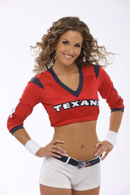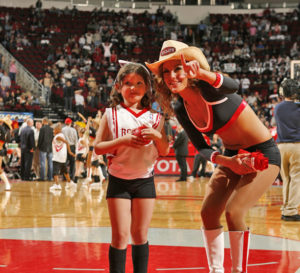 Greetings, all! Bart here with an inspiring interview with Samantha, our newest addition to the Science Cheerleader troop, who has a great story to tell: cheerleader for the NFL and NBA, physical therapist, teacher of future physical therapists, wife, and mom!
Greetings, all! Bart here with an inspiring interview with Samantha, our newest addition to the Science Cheerleader troop, who has a great story to tell: cheerleader for the NFL and NBA, physical therapist, teacher of future physical therapists, wife, and mom!
What turned you on to science and when?
Samantha: I have always had an interest in science and a passion for helping others, but I don’t think I realized it would be my career until I was in high school. I was a counselor at a summer camp for children with disabilities. Leesville Louisiana Lion’s camp is one of places the shaped me into who I am today. It was an eye opening experience for me—I had no idea I could have so much fun and work so hard.
What degrees do you have, and from where?
Samantha: I am originally from Louisiana and got my Bachelors in Kinesiology at LSU. From there, I moved to Houston to attend TWU [Texas Women’s University] where I got my Master’s of Science in Physical Therapy. I attained a clinical doctorate in physical therapy or a DPT from Boston University.
Favorite and/or least favorite courses you took to prepare for your degree? Why?
Samantha: It may sound crazy, but my favorite classes were my physics classes. I had great teachers who inspired me to work hard in high school and college. It was fun using math in application settings and solving problems. Not to mention physics plays a direct role the mechanics of human movement, which I use every day at work as a physical therapist and when I dance.
 What got you interested in physical therapy?
What got you interested in physical therapy?
Samantha: Great question! Growing up I always thought I was going to be a broadcast journalist. I even started out at LSU as a mass communications major. But after one semester, I realized I was in the wrong field. My mom reminded me of how happy I was when I worked at Lion’s Camp, which led me to physical therapy. I knew I was on the right path from the first class I took.
You’re both a teacher and a practicing physical therapist at The Institute for Rehabilitation and Research (TIRR). What’s a typical day like for you?
Samantha: I work in the clinic part time and I teach Therapeutic Exercise as it applies to spinal cord injuries, Parkinson’s Disease, and Multiple Sclerosis in the Fall and TWU and assist with labs with Advanced Spinal Cord Gait Training in the Spring with the University of Texas Medical Branch. I also teach advanced wheelchair skills in the Neuroresidency program at TIRR.
It was definitely a challenge to balance work with cheerleading. I would treat from 8-12 and practice dances and sidelines at lunch then treat again from 1-5pm. I would have a little time to run home grab a bite to eat and head to practice at 7pm.
Tell us about the team(s) you cheer(ed) for and how long you’ve cheered for them.
Samantha: I was with the Houston Rockets 2006-2007. Being a Rockets Power Dancer was an awesome experience. Since there were so many games, we were able to work with all types of dance styles. It challenged me as a dancer to work outside of my comfort zone. Our intro music was “Back in Black” by AC/DC- every time I hear this song I get pretty pumped up. I was with the Houston Texans 2008-2009. Dancing with the Texans was a great experience too! I absolutely love watching football. How awesome was it that I could cheer on my favorite team and dance too!?!
Which came first, your interest in science or cheerleading?
 Samantha: Definitely science. I remember my big brother working on his science fair projects when I was little. I had so much fun when I finally got to do my own. Sure, I took ballet, jazz, and tap when I was young, but I always thought this would just be a hobby. I had no earthly idea that I would ever dance for a professional team.
Samantha: Definitely science. I remember my big brother working on his science fair projects when I was little. I had so much fun when I finally got to do my own. Sure, I took ballet, jazz, and tap when I was young, but I always thought this would just be a hobby. I had no earthly idea that I would ever dance for a professional team.
Did you find that stereotypes about cheerleaders helped or hindered your studies or professional experiences?
Samantha: I feel my participation in professional cheerleading was definitely helpful in all aspects of my life. It keeps you balanced. I could never take myself too seriously. You have to be able to laugh at yourself and be open to critiques. The same applies with work and school. My co-workers and clients were always supportive.
How did your fellow cheerleaders accept your interest in science?
Samantha: I feel like the girls were very accepting of my role as a physical therapist. Anytime someone hurt her neck, shoulder, knee, back, or ankle—they came to me. I loved it! I got to help out a teammate and do what I do best.
Do you have any advice for youngsters who might feel torn between following one dream or another?
Samantha: Do I ever!?! Being a cheerleader does not have to be separate from being intelligent. I feel we don’t need to hide behind a stereotype when we have a lot mor e to share. I was so blessed to have a family who encouraged me to do both. I have 5 beautiful nieces and I do my best to build them up in scholastics as well as athletic activities. It is fun to see them blossom into beautiful girls while kicking tush at track, soccer, and essay writing contests!
e to share. I was so blessed to have a family who encouraged me to do both. I have 5 beautiful nieces and I do my best to build them up in scholastics as well as athletic activities. It is fun to see them blossom into beautiful girls while kicking tush at track, soccer, and essay writing contests!
Along these lines, what advice would you give your 12-year-old self?
Samantha: Ha! It gets better. At 12 years old I was so uncomfortable in my skin and thought there was little I was capable of.
What are your plans for the future?
Samantha: I will continue to work clinically and teach as needed. My greatest accomplishment is my sweet baby boy, who is currently 9 months old. Being a physical therapist and dancing are nothing compared to this career. 🙂
Best cheerleading experience?
Samantha: There are a lot of high-energy experiences as a dancer for a professional team, but I have to say teaching and dancing with the little ones was always a highlight. I was honored to work with the 6-year-olds with the junior cheer program with the Texans and it was a blast. They have enthusiasm for dance and no fear, which is so much fun to work with!!
Best science-related experience?
Samantha: So many! If I had to narrow it down (which is difficult), I would have to say the moment a client walks again. I primarily work with clients who have brain injuries or spinal cord injuries. Every time you show them what they can do, it is amazing! It never gets old.


Please pray for Sam and her family. Cancer has recently been discovered. As her Jr. High Science teacher it just hurts my heart.
You have our prayers.